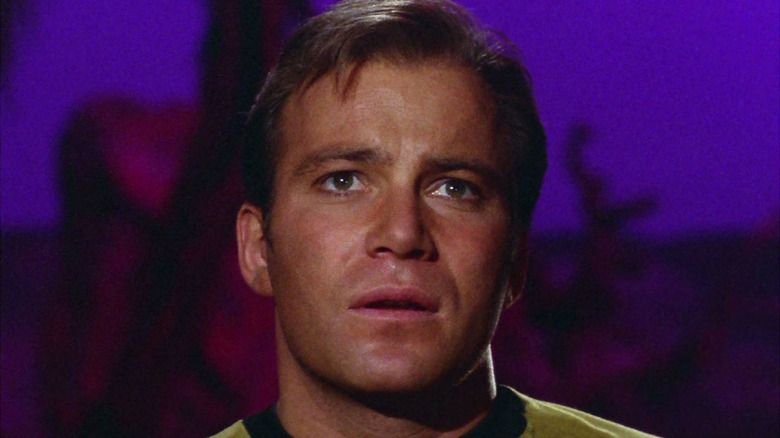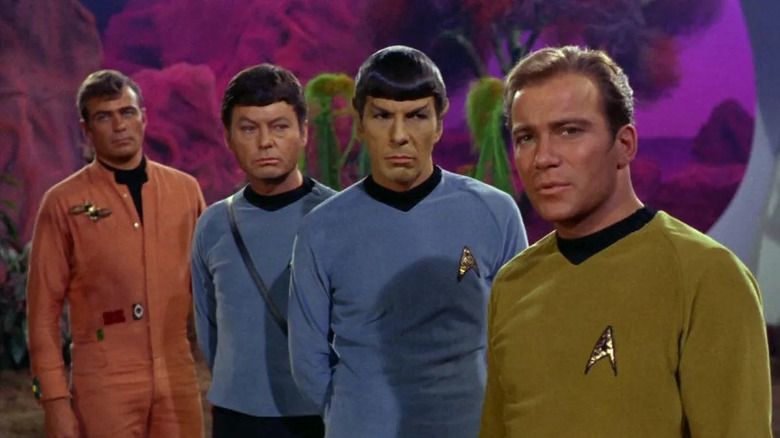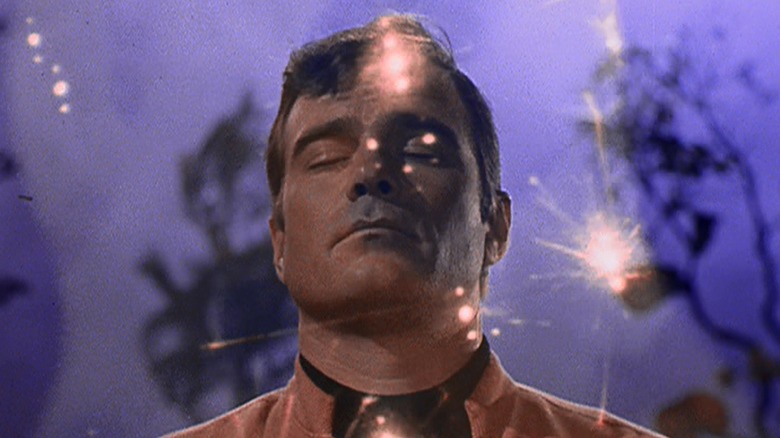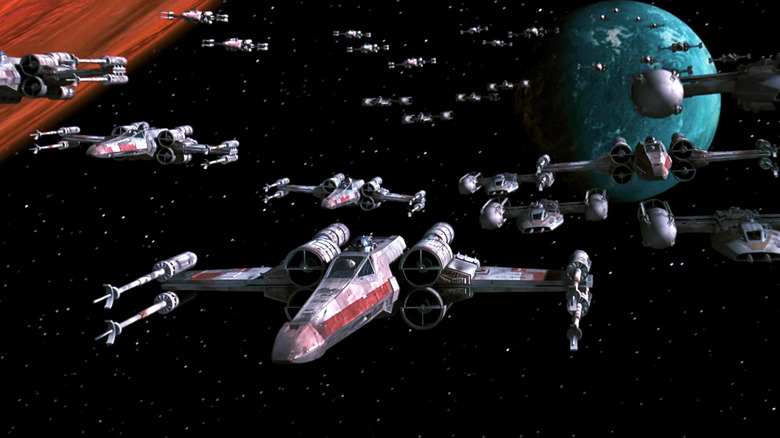A Future Star Wars Legend Lent His Talents To Star Trek For Metamorphosis
A note on revisionism: as many of you out there no doubt already know, it's become de rigueur for studios, corporations and filmmakers themselves to continue to tinker with their works. George Lucas and his "Special Editions" (and subsequent re-revisions) of the "Star Wars" films are the most prominent example of this, and the most illustrative of the concept's drawbacks. For while the idea of a "Director's Cut" or alternate version is a phenomenon that's been employed by everyone from Richard Donner to Michael Mann, Lucas' changes to "Star Wars" were part creative-minded, part "future-proofing" in terms of updating the visual effects to better conform with the Prequel Trilogy.
The most egregious victim of this trend is the original "Star Trek" TV series. Given that "Trek" had gained a (I believe erroneous) reputation for containing chintzy, so-called "dated" visual effects, CBS Television made the choice in 2006 to remaster the 1960s show in HD with new CGI visual effects replacing the old analog ones. While the merits of this choice could certainly be debated at the time, in 2024 the decision looks especially foolish; now that these remastered versions are the default versions available on streaming, the show looks like a bizarre relic of 2006-era effects technology rather than a historical record of what was done in the '60s.
Not only does this sort of thing make the viewing experience more awkward, it effectively erases the pioneering work of the effects artists who made "Star Trek" what it was in the first place. Consider the fact that on episode 9 of the show's second season (an episode entitled "Metamorphosis," directed by Ralph Senensky), the company that had been hired to create the optical effects for the series enlisted the help of a young man named Richard Edlund. Edlund would not only go on to help create the groundbreaking effects for the original "Star Wars" trilogy, but further revolutionize the visual effects industry with his own company, Boss Films.
Edlund makes a literal name for himself on 'Trek'
By the time "Metamorphosis" was in production, Edlund was already an employee at The Westheimer Company, the effects house begun by Joseph Westheimer in 1955 that had worked on shows like "The Twilight Zone" before being hired for "Star Trek" during its first season. The Westheimer Company did not work on every episode of "Trek," as the show's primary effects vendor was the Howard Anderson Company, and Westheimer was viewed as a backup FX house to help out when special FX work got backlogged or needed an extra boost.
One element of the show that Westheimer helped out with (the better to let Howard Anderson focus on the large effects sequences) is the titles. The distinctive and unique titles were not only purpose-built for the series, they were the contribution of Edlund himself. As the effects artist recalled in an interview for the "Roddenberry Vault" special features:
"For my age, at the time, I had a pretty impressive photographic resume and I got a job at Westheimer. Basically I became the Man Friday to [Joseph Westheimer]. I could do a lot of things. I mean, I was a hand-lettering artist and a photographer. Star Trek appeared on the horizon. We did a lot of the titles. I started out by hand-lettering all the titles, which is very, you know, because there's a lot of titles. It used to be, like, hot press, but we couldn't hot press because it wasn't type, so it had to be hand-lettered. So I basically did the entire alphabet and we did phototypeset artwork."
Right away, Edlund was making a name for himself on "Star Trek," literally and figuratively!
How they pulled off the Companion in 'Metamorphosis'
While he had a job at Westheimer, Edlund was attending the USC School of Cinematic Arts, further developing his own experimental techniques. That knowledge came in handy when director Senensky ran into a problem while making "Metamorphosis." In the episode, Kirk (William Shatner), Spock (Leonard NImoy), Bones (DeForest Kelley), and Commissioner Hedford (Elinor Donahue) come across a planetoid where a youthful Zefram Cochrane (Glenn Corbett), the creator of the warp drive, has been marooned by a mysterious alien being known as the Companion.
Although the end of the episode sees the Companion take human form, portraying the entity in its original alien visage proved to be a challenge for Senensky. Fortunately, Westheimer and Edlund (the latter already becoming a specialist at optical work) were able to solve the problem, with Edlund ultimately designing the Companion itself. As Senensky recalled in "Captains' Logs: The Unauthorized Complete Trek Voyages" by Edward Gross and Mark A. Altman:
"We had the problem to cope with of the Companion. We didn't know what it was going to look like, and they didn't know what it was going to look like. What they wanted me to do was shoot it in such a way so that they wouldn't have to do any traveling mattes. In other words, in the scene where you see the Companion and Cochrane in a long shot and then his point of view of Kirk and Spock watching, and then when the Companion engulfs him ... if I had just shot a wide shot with Cochrane to the right of the frame and blank space at the left of the frame for the Companion, and just stayed with that shot so that they would have had to move whatever the optical was across the screen, that becomes very expensive. I worked it out where I would move the camera. They would just be able to do the optical in the middle of the shot and the camera would carry it where they wanted it to go."
Edlund helped start ILM, built Boss Films, and became a legend
After "Star Trek" ended its run in 1969, Edlund went on to make a few experimental short films, and it was this work that brought him to the attention of John Dykstra, who was initially appointed to supervise the effects for Lucas' "Star Wars." Edlund was hired to be the director of photography of the VFX unit for the film, thereby making him a key member of the effects house that ended up becoming known as Industrial Light & Magic.
After a brief sojourn with Dykstra on creating the very "Star Wars"-esque space battles for ABC's "Battlestar Galactica," Edlund became a regular member of ILM, not only working on "Star Wars" sequels "The Empire Strikes Back" (creating optical composites of miniatures against the white backgrounds of the snowy planet Hoth, a task well suited to the Companion's creator) and "Return of the Jedi," but also helping with "Raiders of the Lost Ark" and "Poltergeist." In late 1983, Edlund opened his own effects company, Boss Films, and their resumé reads like a who's who of '80s genre classics: "Ghostbusters," "Fright Night," "2010," "Poltergeist II," "Big Trouble in Little China," "Die Hard," and so on.
By the mid-1990s, Edlund was picking up the baton from his old cohorts at ILM, seeing their pioneering work on "Terminator 2" and "Jurassic Park" and making the steady transition from analog effects to computer generated imagery on films like "Alien 3" and "Species." Edlund's last credit as VFX supervisor is for 2015's "Barely Lethal," so it appears he's effectively retired from the industry. One thing's for sure: the landscape of film and television as we currently know it would look completely different were it not for Edlund's work, which is why it's so important that such work be acknowledged, honored, and preserved.



